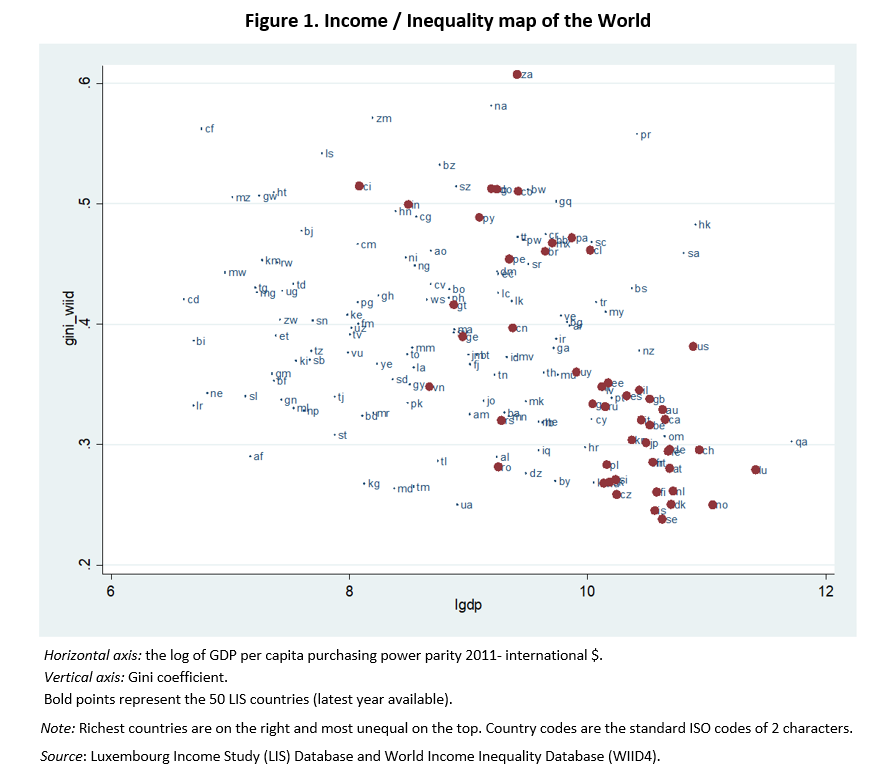Issue, No.10 (June 2019)
LIS is going (further) South: Ivory Coast and Vietnam are now on the map
In completing its collection LIS has now exceeded its target of 50 countries present at least once in the database. With the latest release of the month, LIS can be said to offer a wide-ranging overview of the planet that represents at least 50% of the income/inequality map of the world.
Traditionally, LIS has been a club of the richer, Western countries. In the early systematic comparison of 1994 by Lee Rainwater, Anthony Atkinson and Timothy Smeeding (“Income Distribution in Advanced Economies: The Evidence from the Luxembourg Income Study (LIS)”, the base consisted of 17 Western countries. Since then, LIS has gradually become a much larger project and with the entry of Ivory Coast (CI) and of Vietnam (VN), the world coverage of the income/inequality map (fig.1) is now above 50%.

Vietnam is a typical example of a country now ranked as middle class on the scale of log-incomes; with its Gini index near to .35 it provides an example of moderate inequality. This level is comparable to Canada or many European countries. Due to its rapid economic progress, one can anticipate its level of development quickly catching up with one of several countries of Central Europe such as Romania (RO) or Serbia (RS).
Ivory Coast offers an even newer and more specific example that completes the LIS datasets with an emblematic case of a not-so-poor but still very unequal country in the sub-Saharan Africa context. With a Gini above .5, the introduction of Ivory Coast provides an interesting example of a socio-economically tense case of inequality. In terms of world coverage, it represents a new step in LIS’ development. Even if, for instance, the Democratic Republic of Congo, the Central African Republic and Niger represent instances of even lower-income countries, Ivory Coast will be an interesting case for the LIS community to be able to work with.
A simple comparison of level of living based on income and on consumption shows a reduction of 15 percentage points of the Gini index. An interesting aspect is how inequality is reduced through considerations of consumption: the interdecile ratio is reduced by 55% from 13 to 6, and the interquartile ratio by one third from 3.6 to 2.5. In more detail, the top decile to median declines less than the median to lower decile: this means that consumption is more equal, in particular at the bottom, than living standards.

The same result could be interpreted different ways. In the optimistic view, the poor receive more non-cash transfers, and benefit more from the informal economy or auto-consumption; the pessimistic one is based on savings: if the rich spend more, they can save more. And if the poor consume more, they are at higher risk of over-indebtedness.
Ivory Coast provides rich information including consumption that will provide the possibility of addressing several challenging issues regarding data quality in the future. Even if Ivory Coast and even poorer countries are known through aggregated databases such as SWIID, WIID, etc. (see Jenkins, S.P. , “World income inequality databases: an assessment of WIID and SWIID” The Journal of Economic Inequality, December 2015, Volume 13, Issue 4, pp 629–671 https://doi.org/10.1007/s10888-015-9305-3 ) its inclusion in LIS means entirely different possibilities in terms of analyses. With the microdata availability in LIS, we will be better able to answer some questions such as: Does a non-cash economy have a strong impact on inequality? Is self-production important for poverty reduction? What about the role of inter-household transfers or of local solidarity?
This must be analysed in greater detail but the addition of this new country to LIS means solid progress in the direction of fuller coverage of the diversity of the world of inequalities: the income/inequality map of the world is one step nearer completion.
